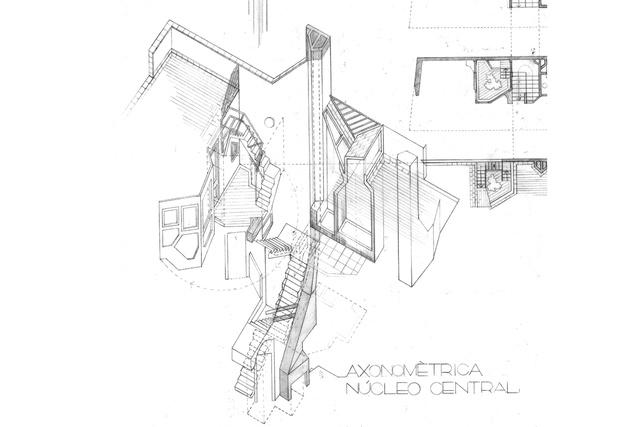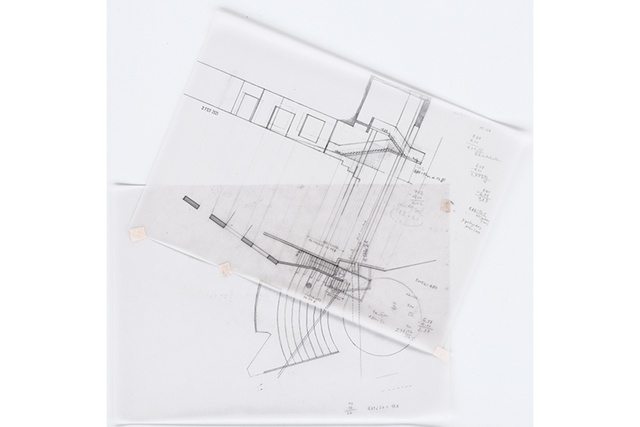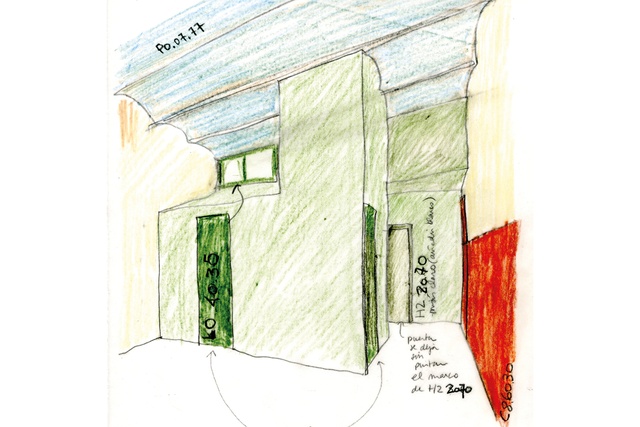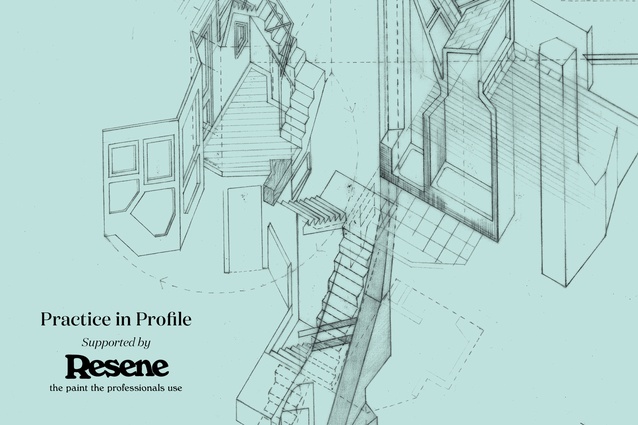Drawn out
In the latest of our Practice in Profile series supported by Resene, Sean Flanagan examines the way in which drawing and seeing are intricately bound and the reasons why hand-drawing makes an efficient and rich contribution to design.
Hand-drawing really matters to some architects. They see it as a significant and dignified kind of work.
Those who appreciate hand-drawing’s intellectual and emotional dimensions believe that the ways in which things are done matter — as though removing the practice could jeopardise the whole enterprise. Just as there simply is no substitute, hand-drawing seems an irreplaceable tradition, one that maintains value despite technological advances promising tools to optimise workflows and make us faster, and more efficient, creative and productive workers.
Hand-drawing devotees offer astute opinions about its contribution. They assert an important link between manufacturing drawings and manufacturing buildings. They’re both handmade. Architects Eva Prats and Ricardo Flores propose that “hands are better at measuring and drawing things that they later will build on site”.1 Billie Tsien and Tod Williams note that their desire to use ‘tools of the hand’ stems from the bodily connection between drawing and building — “Buildings are still constructed with hands, and it seems that the hand still knows best what the hand is capable of doing”.2 Architect and theorist Juhani Pallasmaa values hand-drawing because it is “moulded in the same flesh of physical materiality that the material object being designed and the architect [themselves] embody”.3
This relationship between hand-drawing and building leans on the idea of an extended mind. This theory maintains that cognition — the ways humans sense, learn, think and feel — is an embodied practice, engaging the body’s full corporeal capacities. An example of the extended mind is children learning maths by stepping along a number line marked on the ground. In action, they connect their moving bodies with counting in a way that is beneficial to learning and that extends the idea of maths from being a purely cerebral undertaking to being an embodied form of cognition.4

Cognitive scientists agree that aspects of cognition are realised by the body.5 But philosopher Andy Clark goes further, suggesting that, if cognition is a bodily practice, then we must acknowledge that the mechanisms of the mind are not all in the head.6 Cognition is not purely brain bound. The machinery of the mind, says Clark, extends “beyond the bounds of skin and skull”.7 Cognition “leaks out”8 into the body and the world.
When architects propose a link between hand-drawing and building, they’re identifying the way that a kind of architectural intelligence can work itself out in hand-drawing. With those drawings, this intelligence can be extended — passed hand-to-hand — over to builders who encounter drawn thought to think, measure and build. Bauhaus teacher Josef Albers said drawing was largely a matter of feeling, not seeing. When drawing, you “go by the feeling within the arm”.9 The same can be said of building: that it, too, largely goes by feeling.
A strange and complex interplay can then occur between the body movements used to make hand-drawings and the body movements used to make buildings. Through hand-drawing, a leaky cognitive connection can be made between architects’ and builders’ bodies. This is one way to understand Flores and Prats’ observation that hands are better at drawing the things that hands will later build. There is a continuity of hand work, a dialogue between the architect’s and the builder’s hands. The idea of an extended mind allows both architects and builders to think by hand. Another of hand-drawing’s contributions is its work tempo.
A tempo is the rate or speed at which something happens.10 The idea of a work tempo calls to mind the different lengths of time it takes to do different kinds of work. Acknowledging that work can happen at different tempos allows one to consider how different tempos might foster different outcomes.
If we vary time and tempo, then different things are bound to happen. Working at an increased tempo — think allegro or presto to borrow musical terminology — often means working with tools and techniques that respond to urgency and favour intuitive and spontaneous thought. Conversely, working at a reduced tempo — think adagio or lento — favours tools and techniques that work in decelerated ways and support immersive, reflective cognition.
“Hand-drawing is time sensitive. Hands can move quickly and slowly, with lines made both deliberately — via a careful rephrasing and retracing of marks — and swiftly, with power and propulsion.”
Architects who value hand-drawing tend to consider it a decelerated kind of work. They think it has value precisely because it shapes thought slowly. “As our hands move,” write Williams and Tsien, “we have the time to think and to observe our actions.”11
Hand-drawing is time sensitive. Hands can move quickly and slowly, with lines made both deliberately — via a careful rephrasing and retracing of marks — and swiftly, with power and propulsion.12 But, at all speeds, hand-drawing involves what Edward Hill describes as the “excitement of the moving hand”.13 It is a bodily practice.
Hands move to the body’s tempo. They can’t go non-stop. They follow a biological cycle of “vigour and fatigue”,14 a cycle philosophers say echoes other natural rhythms. Rest is needed to manage fatigue and, whilst hand-drawing may not be the most taxing of labours, there still comes a time when the pencil grows heavy in one’s hand.
Many complex conditions shape hand-drawing’s biological tempo. Fast and slow, stopping and starting, it’s a pace that lends the drawer time to think and observe, as Williams and Tsien note. This tempo supports reflection and fosters a gradual, drawn-out way of working. These qualities are particular to this tempo.15

Hand-drawing’s decelerated pace is tied to bodily dynamics but it’s possible to engineer even slower techniques for enhanced deceleration. Flores and Prats ask students to hand-draw with drafting tools like triangles and compasses to slow the practice further deliberately. With the tempo lowered and a generous amount of time set aside, they find thinking — for students and practitioners alike — becomes deeply immersive.
There is time for systematic investigation, discovery and reflection. There is time to consider alternative paths. There is time for uncertainty as there’s no time pressure forcing reliance on the mind’s archived plans, established knowledge or reflex actions. There’s no pressure to follow first impressions to a definitive conclusion quickly. Instead, there’s an opportunity to contemplate things and think beyond surface appearances. This kind of thinking is intricately bound to hand-drawing. Hand-drawing is a very efficient way to inspire this important kind of thought.
“There is time for systematic investigation, discovery and reflection. There is time to consider alternative paths. There is time for uncertainty as there’s no time pressure forcing reliance on the mind’s archived plans, established knowledge or reflex actions.”
Flores and Prats give their students permission to slow down and gain confidence in the formative powers of prolonged work. When you stop racing the clock, then lots of things are allowed to come to mind.16 This slower, embodied tempo leads to an important lesson about architectural design as Flores and Prats explain: “An especially important lesson that we hope students understand from our studios is that the design process is not linear and smooth, but rather composed of loops, pauses, tests, and alternative versions. In that sense, drawing by hand is still more efficient and richer.”17
Humans are “intrinsically loopy creatures”,18 says Clark, echoing Flores’ and Prats’ observation about design being composed of loops. Thought involves rhythmical loops of action and pause, the testing of alternatives, work and rework. This is cognition’s character.
The loops criss-cross the boundaries of mind, body and world.19 By this, Clark means that biological intelligence comes into being in a strange loop through the organic matter of the brain, the mechanical and sensory capabilities of the body, and our engagement with the material world and its contingencies. Thinking happens in the round and through this loop.
Clark would wholeheartedly agree with Flores and Prats that hand-drawing makes an efficient and rich contribution to design. It’s all loopy, biological and bodily stuff. In fact, Clark uses an architect’s hand-sketches to explain loopy cognition.20 If you’re an architect using sketches, you’re not having an idea in your head, offloading it onto paper, and then reloading it into your brain, he says. The thought process is, in fact, extended through drawing. It is taking place in the moment of drawing, and in this loop through the body, and through internal and external modes of cognition.21
Clark’s observations echo those made decades ago by William Kirby Lockard in his book Drawing as a Means to Architecture. Writing in the 1970s, when hand-drawing was the dominant mode of production, Lockard maintained hand-drawing was not the off-loading of ideas onto paper. It was not a simple ‘printout’ of decisions.22 To consider hand-drawing in such a way is inhibitive and debilitating, but Lockard says it was popular because of the cultural dominance of a linear idea that conception precedes action.

But, drawing on his experience, Lockard said something more ‘mysterious’ was at work. Cognition and action can enigmatically intertwine, as they seemed to do when he held a pencil in his hand. Then, the subconscious mind can play a part and we can be open to the opportunities of seeing and learning from things that appear in hand-drawings as they’re made.
Hand-drawings are not records of abstract thought. Action can front-foot conception. Lockard maintained thinking this way empowers us to expect much more: “Design drawings should be made in anticipation and confidence that design opportunities will appear in the drawings that were not preconceived.”23
Psychologists know we think with our hands and especially so when it comes to thinking about spatial relationships. “When people are asked to explain or describe spatial relationships while sitting on their hands, they have trouble speaking. They can’t find the words”,24 writes psychologist Barbara Tversky. Limiting movement disrupts thinking. For architects, so concerned with spatial relationships, there are rich opportunities in moving hands and engaging bodies and extending the body’s capabilities with tools like pencils and paper. Cognition then happens in a tactile, material and mobile way. Then, we can reap its full rewards, consciously and otherwise. Hand-drawing will show us things we’d not otherwise conceive. But these rewards intertwine with a decelerated tempo and a measured, reflective course of action. It’s a gradual process.
Hand-drawing is biological and loopy, and taking the proper time to do it is both vital and efficient. The opportunities it affords are inseparable from its decelerated tempo and inseparable from the opportunities and constraints the body inspires. When it comes to thinking about architecture, there’s no substitute for hand-drawing nor the time it takes. It’s certainly not the only way to work but nothing works in quite the same way.

Sean Flanagan is an architect in Tāmaki Makaurau. He reads a few books and occasionally writes something, too. Many thanks to Lamplight Books in Parnell for going above and beyond in sourcing the research material for this piece.
References
1. Ricardo Flores and Eva Prats, 2021, Thought by Hand: The Architecture of Flores & Prats. Mexico City: Arquine, p. 138.
2. Billie Tsien and Tod Williams, 1999, ‘On Slowness’, 2G International Architecture Review, 9, no. 1.
3. Juhani Pallasmaa, 2009, The Thinking Hand: Existential and Embodied Wisdom in Architecture. New Jersey: Wiley, p. 95.
4. Annie Murphy Paul, 2022, The Extended Mind: The Power of Thinking Outside the Brain. Boston: Mariner Books, p. 58.
5. Andy Clark, 2010, Supersizing the Mind: Embodiment, Action, and Cognitive Extension. Oxford: Oxford University Press, p. 82.
6. Clark, 2010, p. 82.
7. Clark, 2010, p. 76.
8. Clark, 2010, p. xxviii.
9. Glenn Adamson, 2007, Thinking through Craft. London: Bloomsbury, p. 84.
10. ‘Tempo’ has its root in the Latin ‘tempus’, meaning ‘time’.
11. Tsien and Williams, 1999, p. 131.
12. Edward Hill, 1966, The Language of Drawing. New Jersey: Prentice-Hall, p. 2.
13. Hill, 1966, p. 2.
14. Erazim Kohák, 2015, The Embers and the Stars. Chicago: University of Chicago Press, p. 5.
15. The idea that particular qualities come to the fore with particular tempos has a musical correlation. The qualities fostered by one musical tempo cannot be exactly replicated by another. The unhurried adagio, for example, specifically creates an atmosphere of introspection in which compositions take on profound emotional dimensions. For the players, the decelerated tempo requires careful control of musical phrasing and articulation. Unhurried, their playing is laid bare, to be heard and experienced in detail. This is, in part, why composers turn to the adagio for deep expression because it calls nuanced details to the fore. Listeners are invited to savour notes, tones and phrase
16. Ricardo Flores, 2017, “Because they are very slow to do, hard line drawings with the triangles, and all that, with a hand. And a lot of things come in. We are not so much interested in the speed of the machine in the moment of thinking because then it goes so fast, that doesn’t allow you to think.” ‘Register Flores and Prats’, interview by Andrew Clancy, Register Architecture and Landscape, 17 February 2017,
17. Ricardo Flores and Eva Prats, 2023, ‘Pan, Scroll, Zoom’, in Moises Puente (ed.), Flores & Prats: Drawing Without Erasing and Other Essays. Cologne: Walther & Franz König, p. 104.
18. Andy Clark, 2019, ‘Extended You’, filmed October at TEDxLambeth, London, video.
19. Andy Clark, 2010, p. xxviii.
20. Andy Clark, 2019, “If you’re an architect and using sketches, it’s not like you’re having the thought and then off-loading it and then reloading it. The whole process of thinking is extended through the brain, body and that bit of the material world.”
21. Psychologist Barbara Tversky has observed a similar loopy process in experimental studies of architects and designers at work. She writes: “Designers are said to have conversations with their sketches, cycles of thinking, drawing, looking, rethinking, redrawing, and so on, gradually refining a design.” Barbara Tversky, 2019, Mind in Motion: How Action Shapes Thought. New York: Basic Books, p. 262.
22. William Kirby Lockard, 1977, Drawing as a Means to Architecture. Tucson: Pepper Publishing, p. 35.
23. Lockard, 1977, p. 35. Reiterating Lockard’s position, Pallasmaa, too, cycles through the origins of architectural images and ideas and lands again at the opportunities hand-drawing affords for things to rise up and appear to consciousness through making: “One cannot know whether the image first arose in one’s mind, and was then recorded by hand, or whether the image was produced by the hand independently, or whether it emerged as a result of a seamless collaboration of the hand and the drawer’s mental space. It is often the act of drawing itself, the deep engagement in the act of unconscious thinking through making, that gives rise to an image or an idea.” (Pallasmaa 2009, p. 95.)
24. Tversky, 2019, p. 124.











